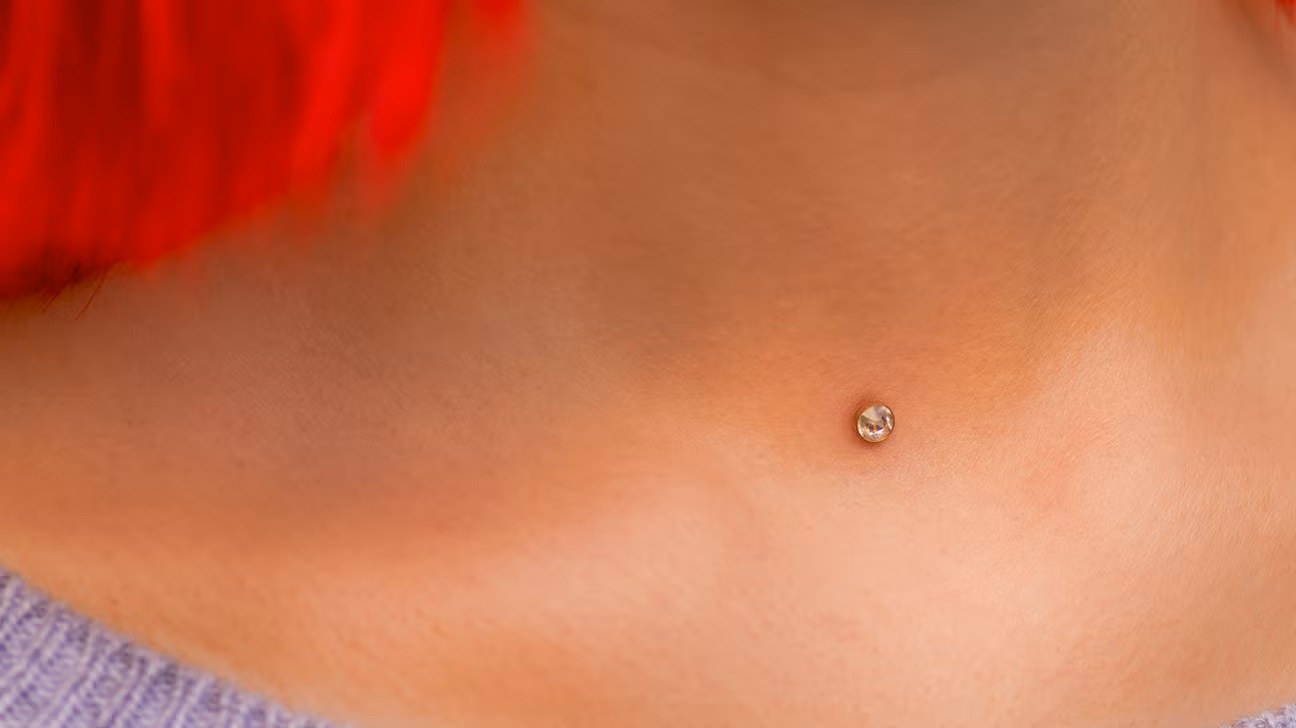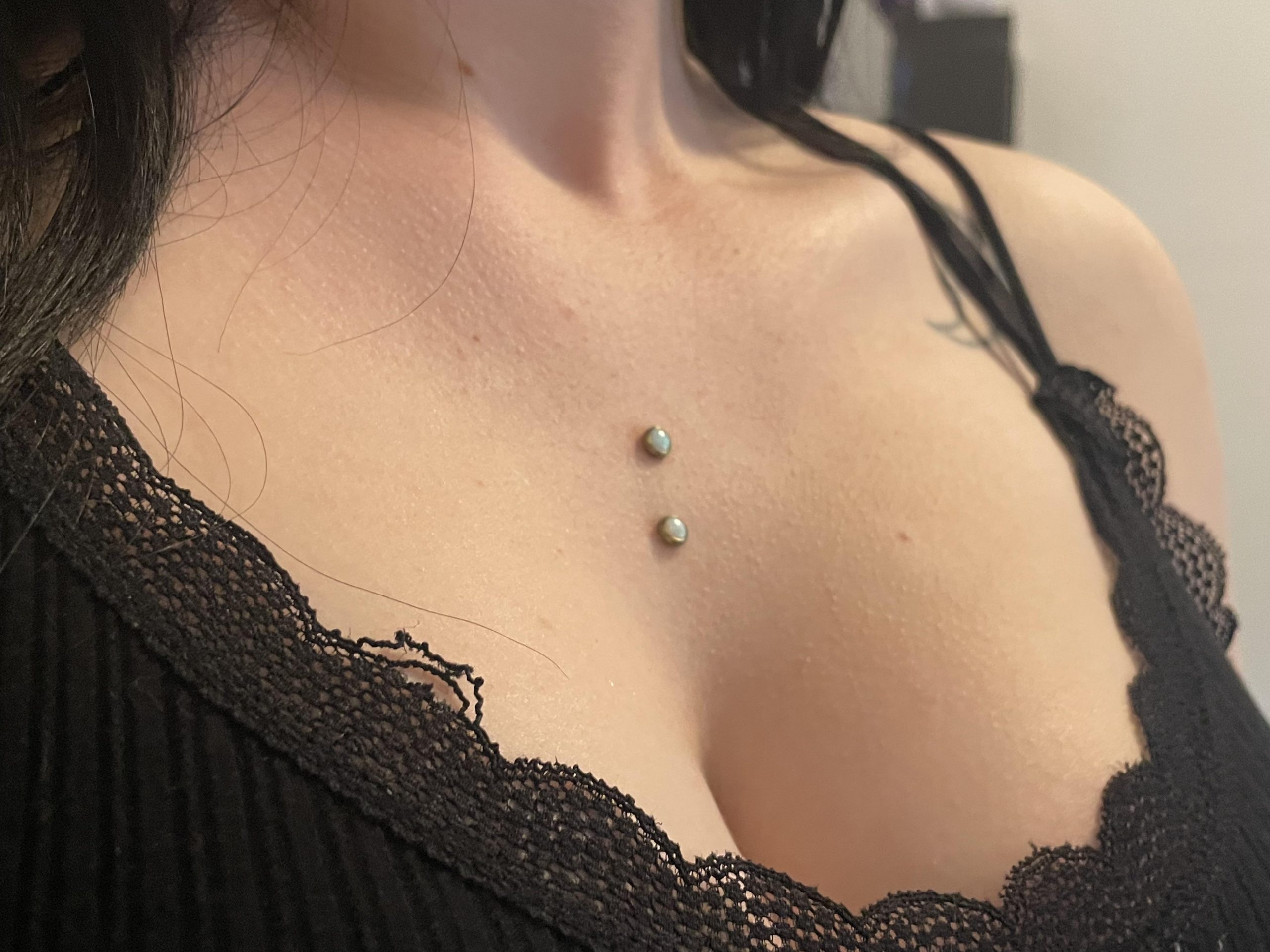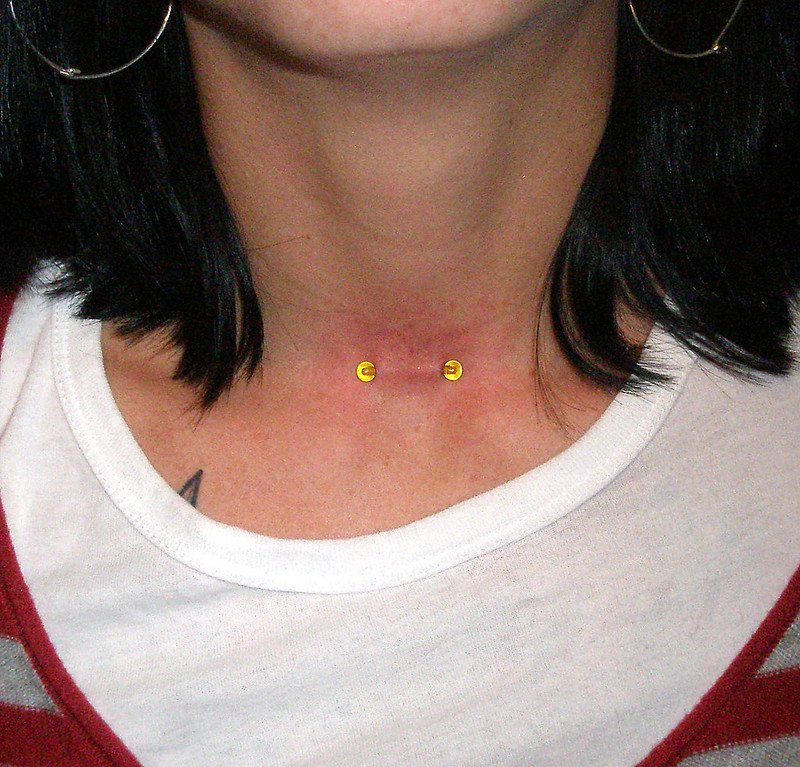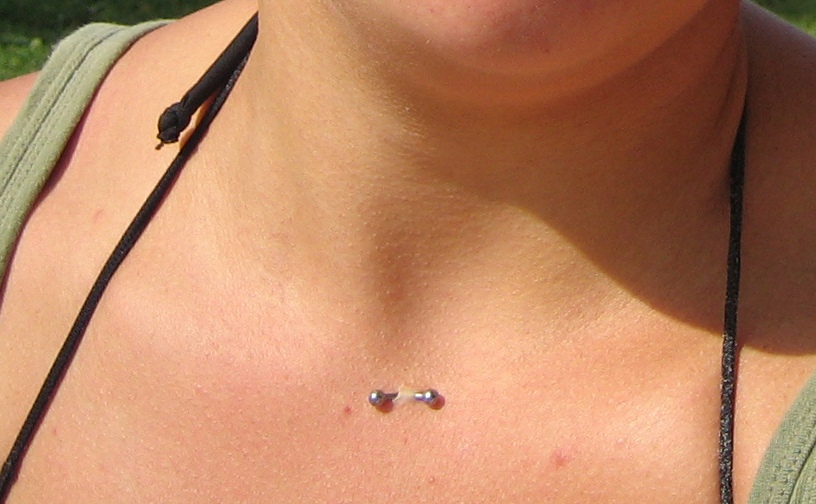In the landscape of body art, certain piercings are chosen for their quiet, unexpected elegance. The Madison piercing is the epitome of this philosophy. Placed horizontally in the suprasternal notch—the delicate, soft hollow at the base of the throat, nestled perfectly between the collarbones—it is a single, captivating statement. It doesn’t shout; it whispers. It’s a sophisticated accent that draws the eye, a point of light that is both alluringly discreet and confidently placed, making it a powerful choice for the discerning piercing enthusiast.
However, the understated beauty of a healed Madison piercing conceals a significant technical complexity and a high potential for complications. As a true surface piercing in one of the most mobile and high-friction areas of the body, its success is a direct testament to the piercer’s expertise and the client’s dedication. At PinkTatPier, we approach this piercing with the profound respect and meticulous planning it demands. We recently had a consultation with a client, Sam, who came to us with an angry, red, and irritated scar in his suprasternal notch from a failed Madison piercing performed at another studio. He was understandably disheartened but still in love with the piercing’s aesthetic.
Our lead specialist began by carefully examining the old scar, immediately identifying the cause of the failure: it had been pierced with a curved barbell, the incorrect jewellery, which guarantees rejection. Our first step was not to re-pierce. Instead, we provided Sam with a detailed scar-care regimen to help the tissue recover its health and elasticity over several months. Once the area was stable, he returned for a new consultation. We showed him a proper, staple-shaped surface bar, explaining in detail how its flat design works with the body’s tension, not against it. The new piercing we eventually performed for him sat flush, flat, and calm against his skin—a stark, visible contrast to his previous painful experience. This story is a powerful testament to our core belief: that for advanced piercings, education and expert technique are the foundation of everything.
This definitive guide is an extension of that honest, expert-led experience. It is the most comprehensive resource for anyone seriously considering a Madison piercing London, designed to give you the unvarnished truth about the procedure, the critical importance of correct jewellery, the demanding healing journey, and how to book your consultation with our experts.

Madison piercing
Deconstructing the Madison: A True Surface Piercing, Not a Dermal
To make a fully informed decision, you must first understand the mechanics of this piercing. It is fundamentally different from a traditional piercing and requires specialised jewellery and techniques.
The Definition: A Horizontal Bar Beneath the Skin
A Madison piercing is a single piercing channel that runs horizontally under the surface of the skin at the base of the neck. It has two visible ends, typically adorned with simple beads or sparkling gems, which creates the illusion of two separate piercings. In reality, these two ends are connected by a single, solid bar of jewellery that sits hidden just beneath the skin.
The Most Critical Factor: Jewellery Shape Dictates Success or Failure
This is the single most important piece of information in this entire guide, and the detail that separates a true professional from an amateur who will cause you harm.
- The WRONG Jewellery (Curved Barbell): Many inexperienced or under-equipped piercers will attempt to perform a Madison piercing with a long, curved barbell (like one used for a navel piercing). This is guaranteed to fail. The “C” shape of the barbell creates constant, uneven, outward pressure on the entry and exit holes. Your body’s natural response to this relentless tension is to push the foreign object out to relieve the pressure. This process, known as rejection, is not a possibility; it is an inevitability with a curved barbell. It will lead to chronic inflammation, migration (the piercing moving from its original spot), and will always end with the piercing being forced out, leaving behind a prominent, often unsightly, linear scar.
- The CORRECT Jewellery (Surface Bar): A true professional service for a Madison piercing London will exclusively use a piece of jewellery called a “surface bar.” This is a specially designed piece of jewellery shaped like a staple. It has a long, flat bar that sits parallel and neutrally underneath the skin, connected to two 9-degree posts that rise up to the surface. This design eliminates the tension and gives the body the best possible chance to heal calmly around the jewellery. At PinkTatPier, we use only high-quality, implant-grade titanium surface bars, often custom-sized to perfectly match the client’s anatomy.
The High-Stakes Environment: Why the Madison Placement is So Challenging
The suprasternal notch is one of the most difficult places on the body to successfully heal a piercing. Its environment is in a constant state of flux, presenting several major challenges that you must be prepared for.

Madison piercing
Constant, Unavoidable Movement
The base of your throat is a nexus of near-constant motion. Think about your daily, subconscious movements:
- Head and Neck Movement: Every time you turn your head, look up or down, or nod, the skin in that area stretches, compresses, and moves.
- Shoulder and Arm Movement: Shrugging your shoulders or reaching your arms forward pulls on the skin of the upper chest.
- Breathing and Swallowing: Even the simple acts of breathing deeply and swallowing cause subtle but constant motion in the tissue. This constant movement puts significant stress on a healing piercing channel, disrupting the fragile new tissue and dramatically prolonging the healing process.
The Ultimate Snagging Gauntlet: Clothing, Necklaces, and Daily Life
This is the number one cause of failure for even a perfectly performed Madison piercing. The list of potential hazards is extensive and requires a total shift in your daily mindfulness.
- Clothing: High-collared shirts, jumpers, scarves, and jackets will constantly rub against the piercing, causing friction and irritation that can lead to rejection.
- Necklaces and Pendants: These are an absolute no-go during the entire healing period, as they can easily catch on the jewellery and cause a traumatic tear.
- Straps: Seatbelts, handbag straps, and backpack straps can all snag or apply painful pressure.
- Towels, Hair, and Sleep: Drying yourself after a shower, long hair getting tangled, or rolling over in your sleep can all lead to an accidental and devastating snag.
The PinkTatPier Professional Service: A Journey in Precision
Our comprehensive service is an end-to-end process, meticulously designed to maximise safety and give your piercing the best possible chance of long-term success.
The In-Depth Consultation and Precision Marking
Your journey begins with a mandatory, in-depth consultation. We will perform a thorough “pinch test,” gently assessing the tissue in your suprasternal notch to ensure there is enough pliable skin to safely support the surface bar. If your anatomy is suitable, the consultation becomes a collaborative design session. We use a sterile marker and callipers to meticulously map the placement, ensuring it is perfectly level, centered, and sits beautifully within the hollow of your throat.
The Specialist Piercing Technique
A Madison piercing is an advanced freehand technique. Your specialist will use a single-use, hollow needle to create a clean, precise channel at the exact depth required to accommodate the surface bar. The jewellery is then inserted in a smooth, atraumatic motion. The entire procedure is performed with the highest standards of hygiene in our clinical-grade studio by one of our senior piercers with extensive experience in advanced surface work.
The Healing Timeline: A Marathon of Meticulous Care
Healing a Madison piercing is a long-term commitment that requires immense patience and a near-perfect aftercare routine.
Table: The Madison Piercing Healing & Aftercare Guide
A Madison piercing London is an advanced procedure, and our pricing reflects the high level of skill, time, and specialist jewellery required.
The final cost is custom and can only be provided during your mandatory, in-person consultation. This is because the price depends on the specific size and style of the surface bar required for your anatomy, as well as the decorative ends you choose. To begin the process, use our online reservation system to book an “Advanced Piercing Consultation.”

Madison piercing
Your 5 Most Important Questions Answered (FAQ)
1. Why is this piercing so much more prone to rejection than others?
There are three primary reasons: 1) It’s a surface piercing, which naturally sits under more tension than a traditional piercing. 2) It’s in a location of extremely high, multi-directional movement (neck, shoulders, chest). 3) It’s in a prime location for friction and snagging from clothing and daily life. This combination of factors creates a challenging environment that the body may decide to “evict” the jewellery from over time.
2. What are the very first signs of rejection I should look for?
Rejection is often a slow, quiet process. The earliest signs are subtle: the skin over the bar might start to look a little shiny, pink, or thin, almost like a stretch mark. You might notice that a tiny bit more of the bar is visible than when you were first pierced. The holes might look a little wider or more oval-shaped. It is typically not painful. If you see any of these signs, contact us immediately for a check-up.
3. Will the scar be very bad if it rejects or I have it removed?
If the jewellery is removed professionally at the first sign of rejection, the scarring is typically minimal—two small, dot-like scars that will fade significantly over time. However, if the piercing is left to reject completely on its own, it will leave a more noticeable, linear scar connecting the two points. This is why early detection and professional removal are so crucial.
4. How can I realistically protect it from my clothes and necklaces?
You must make a conscious commitment to changing your habits. For the entire healing period (up to a year or more), this means exclusively wearing low-cut tops like scoop necks or V-necks. All necklaces, scarves, and high-collared jackets must be avoided. When you sleep, try to stay on your back. When drying yourself after a shower, you must learn to gently pat the area dry, never rubbing with a towel. It requires constant mindfulness.
5. Is a dermal anchor a better option than a surface bar for this spot?
This is an excellent, technical question. While a single dermal anchor can be placed in this location, it is generally considered less stable than a surface bar for a Madison. A surface bar has two points of contact under the skin, distributing the tension more evenly and providing more resistance to the rocking and pulling forces that are so common in this area. A single-point dermal anchor is more easily snagged and dislodged. For the Madison placement, a surface bar is almost always the superior and more professional choice.
Conclusion: A Piercing Where Expertise is Everything
The Madison piercing is a stunning, high-impact piercing for the individual who understands and respects its unique and demanding challenges. It is a piercing where the difference between a beautiful, long-term success and a failed piercing with a prominent scar lies almost entirely in the hands of the piercer and their non-negotiable use of the correct jewellery. By choosing a true specialist who understands surface piercing mechanics, you are making the only choice that offers a genuine chance of success.

Madison piercing
Your Next Step: Begin with an Expert Consultation
Don’t risk the health of your skin on improper technique or incorrect jewellery. If you are ready to commit to a beautiful, professionally executed Madison piercing London, your first step is a serious conversation with an expert.
Use our easy online reservation system to book your in-depth consultation with our experts today. Let us provide you with the honest, professional guidance and a custom cost quote that this advanced piercing demands.

